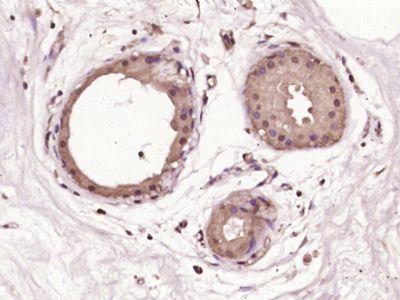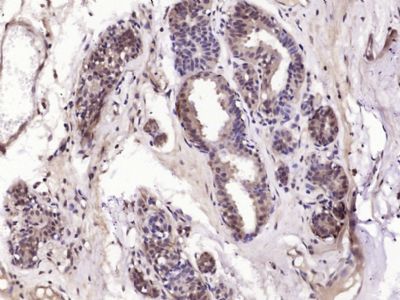ESE1 Polyclonal Antibody
Purified Rabbit Polyclonal Antibody (Pab)
- 产品详情
- 实验流程
Application
| WB, IHC-P, IHC-F, IF, ICC, E |
|---|---|
| Primary Accession | P78545 |
| Reactivity | Rat, Dog, Bovine |
| Host | Rabbit |
| Clonality | Polyclonal |
| Calculated MW | 41454 Da |
| Physical State | Liquid |
| Immunogen | KLH conjugated synthetic peptide derived from human ESE1 |
| Epitope Specificity | 201-300/371 |
| Isotype | IgG |
| Purity | affinity purified by Protein A |
| Buffer | 0.01M TBS (pH7.4) with 1% BSA, 0.02% Proclin300 and 50% Glycerol. |
| SUBCELLULAR LOCATION | Cytoplasm. Nucleus. Localizes to the cytoplasm where it has been shown to transform MCF-12A mammary epithelial cells via a novel cytoplasmic mechanism. Also transiently expressed and localized to the nucleus where it induces apoptosis in non-transformed breast epithelial cells MCF-10A and MCF-12A via a transcription-dependent mechanism. |
| SIMILARITY | Belongs to the ETS family. Contains 1 ETS DNA-binding domain. Contains 1 PNT (pointed) domain. |
| SUBUNIT | Interacts with TBP. Interacts with CREBBP and EP300; these act as transcriptional coactivators of ELF3 and positively modulate its function. Interacts with XRCC5/KU86 and XRCC6/KU70; these inhibit the ability of ELF3 to bind DNA and negatively modulate its transcriptional activity. Associated with CLND7 and POU2F3. |
| Important Note | This product as supplied is intended for research use only, not for use in human, therapeutic or diagnostic applications. |
| Background Descriptions | ESE-1, a member of the Ets family of transcription factors, critically regulates epithelial cell differentiation and mediates vascular inflammation. ESE-1 is strongly expressed in vascular endothelium and smooth muscle cells where it is induced in response to inflammatory cytokines and lipopolysaccharides, interacts with NF-KappaB to induce nitric oxide synthase, and is induced during terminal differentiation of epidermal and primary keratinocytes. In addition, ESE-1 is upregulated upon differentiation of corneal epithelium and interacts with Sp1 and AP-1 proteins to induce squamous differentiation marker expression in bronchial epithelial cells. |
| Gene ID | 1999 |
|---|---|
| Other Names | ETS-related transcription factor Elf-3, E74-like factor 3, Epithelial-restricted with serine box, Epithelium-restricted Ets protein ESX, Epithelium-specific Ets transcription factor 1, ESE-1, ELF3 (HGNC:3318) |
| Target/Specificity | Expressed exclusively in tissues containing a high content of terminally differentiated epithelial cells including mammary gland, colon, trachea, kidney, prostate, uterus, stomach and skin. |
| Dilution | WB=1:500-2000,IHC-P=1:100-500,IHC-F=1:100-500,ICC=1:100-500,IF=1:100-500,ELISA=1:5000-10000 |
| Format | 0.01M TBS(pH7.4) with 1% BSA, 0.09% (W/V) sodium azide and 50% Glyce |
| Storage | Store at -20 °C for one year. Avoid repeated freeze/thaw cycles. When reconstituted in sterile pH 7.4 0.01M PBS or diluent of antibody the antibody is stable for at least two weeks at 2-4 °C. |
| Name | ELF3 (HGNC:3318) |
|---|---|
| Function | Transcriptional activator that binds and transactivates ETS sequences containing the consensus nucleotide core sequence GGA[AT]. Acts synergistically with POU2F3 to transactivate the SPRR2A promoter and with RUNX1 to transactivate the ANGPT1 promoter. Also transactivates collagenase, CCL20, CLND7, FLG, KRT8, NOS2, PTGS2, SPRR2B, TGFBR2 and TGM3 promoters. Represses KRT4 promoter activity. Involved in mediating vascular inflammation. May play an important role in epithelial cell differentiation and tumorigenesis. May be a critical downstream effector of the ERBB2 signaling pathway. May be associated with mammary gland development and involution. Plays an important role in the regulation of transcription with TATA-less promoters in preimplantation embryos, which is essential in preimplantation development (By similarity). |
| Cellular Location | Cytoplasm. Nucleus {ECO:0000255|PROSITE-ProRule:PRU00237, ECO:0000269|PubMed:10391676, ECO:0000269|PubMed:15169914, ECO:0000269|PubMed:17060315} Note=Localizes to the cytoplasm where it has been shown to transform MCF-12A mammary epithelial cells via a novel cytoplasmic mechanism Also transiently expressed and localized to the nucleus where it induces apoptosis in non-transformed breast epithelial cells MCF-10A and MCF-12A via a transcription-dependent mechanism |
| Tissue Location | Expressed exclusively in tissues containing a high content of terminally differentiated epithelial cells including mammary gland, colon, trachea, kidney, prostate, uterus, stomach and skin |
Research Areas
For Research Use Only. Not For Use In Diagnostic Procedures.
Application Protocols
Provided below are standard protocols that you may find useful for product applications.
终于等到您。ABCEPTA(百远生物)抗体产品。
点击下方“我要评价 ”按钮提交您的反馈信息,您的反馈和评价是我们最宝贵的财富之一,
我们将在1-3个工作日内处理您的反馈信息。
如有疑问,联系:0512-88856768 tech-china@abcepta.com.
¥ 1,500.00
Cat# AP54442























 癌症的基本特征包括细胞增殖、血管生成、迁移、凋亡逃避机制和细胞永生等。找到癌症发生过程中这些通路的关键标记物和对应的抗体用于检测至关重要。
癌症的基本特征包括细胞增殖、血管生成、迁移、凋亡逃避机制和细胞永生等。找到癌症发生过程中这些通路的关键标记物和对应的抗体用于检测至关重要。 为您推荐一个泛素化位点预测神器——泛素化分析工具,可以为您的蛋白的泛素化位点作出预测和评分。
为您推荐一个泛素化位点预测神器——泛素化分析工具,可以为您的蛋白的泛素化位点作出预测和评分。 细胞自噬受体图形绘图工具为你的蛋白的细胞受体结合位点作出预测和评分,识别结合到自噬通路中的蛋白是非常重要的,便于让我们理解自噬在正常生理、病理过程中的作用,如发育、细胞分化、神经退化性疾病、压力条件下、感染和癌症。
细胞自噬受体图形绘图工具为你的蛋白的细胞受体结合位点作出预测和评分,识别结合到自噬通路中的蛋白是非常重要的,便于让我们理解自噬在正常生理、病理过程中的作用,如发育、细胞分化、神经退化性疾病、压力条件下、感染和癌症。







